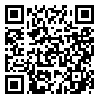1. Onyishi EI, Sorokowski P, Sorokowska A, Pipitone RN. Children and marital satisfaction in a non-Western sample: having more children increases marital satisfaction among the Igbo people of Nigeria. Evol Hum Behav. 2012;33(6):771–4. [
DOI]
2. Dragiewicz M. Blind to betrayal: why we fool ourselves we aren’t being fooled by Jennifer J. Freyd and Pamela J. Birrell (Wiley, 2013). The Criminologist. 2013;38(5):60–1.
3. Jeanfreau MM, Jurich AP, Mong MD. Risk factors associated with women’s marital infidelity. Contemp Fam Ther. 2014;36(3):327–32. [
DOI]
4. Jones DN, Weiser DA. Differential infidelity patterns among the dark Triad. Pers Individ Dif. 2014;57:20–4. [
DOI]
5. Williams JG. The psychology of childhood to maturity. Amsterdam: Butterworth-Heinemann; 2013.
6. Fakhimi Farhadi R, Sheikhi P, Alizadeh A, Alizadeh A. Moghayeseye ravesh haye maser dar kontorol khashm az didgahe Islam va elme ravan shensi [Comparison of effective methods in controlling anger from the perspective of Islam and psychology]. In: Second National Conference on Social Injuries [Internet]. Ardabil; 2020. [Persian]
7. Sanagoei Zadeh M. Regular self-care pattern (RSC) in marital intimacy arising from an Islamic perspective. Cultural Psychology. 2021;5(1):166–94. [Persian] [
Article]
8. Larsen RJ, Buss DM, Wismeijer A, Song J, Van Den Berg S. Personality psychology: domains of knowledge about human nature. London: McGraw Hill Education; 2017.
9. Hertlein KM, Wetchler JL, Piercy FP. Infidelity: an overview. Journal of Couple & Relationship Therapy. 2005;4(2):5-16. [
DOI]
10. Sadock BJ, Sadock VA, Kaplan HI. Kaplan & Sadock's synopsis of psychiatry: behavioral sciences/clinical psychiatry. Philadelphia: Walters Kluwer; 2007.
11. Thompson AP. Emotional and sexual components of extramarital relations. Journal of Marriage & the Family. 1984;46:35-42.
12. Mousavizadeh S, Torani S, Sohrabi F. Female students becoming assertive as a way of increasing marital satisfaction. Journal of Psychological Studies. 2013;9(2):131-52. [Persian] [
DOI]
13. Hoyle RH, Fejfar MC, Miller JD. Personality and sexual risk taking: a quantitative review. J Pers. 2000;68(6):1203–31. [
DOI]
14. Fathi M, Parvin S, Javadian SR. Comparing the causes of infidelity in marital relationships among men and women: a qualitative research. J Qual Res Health Sci. 2016;5(4):401–18. [Persian] [
Article]
15. Motahari M. Dah goftar [Ten speeches]. Tehran: Sadra Pub; 2009. [Persian]
16. Omidi A, Akbari H, Jadi Arani TS. Efficacy of educational workshop on self-esteem of students at Kashan university of medical sciences. Feyz. 2011;15(2):114-9. [Persian] [
Article]
17. Gholamniya Foumani M, Sadeghi N, Dehghanzadeh Sh. Self-esteem and self-confidence relationship with religious tendency in families with a child suffering from cancer. AIMS Medical Science. 2019;6(3):218-29. [
DOI]
18. Patton JH, Stanford MS, Barratt ES. Factor structure of the Barratt Impulsiveness Scale. J Clin Psychol. 1995;51:768–74. [
DOI]
19. Javid M, Mohammadi N, Rahimi Ch. Psychometric properties of an Iranian version of the Barratt Impulsiveness Scale-11 (BIS-11). Journal of Psychological Methods and Models. 2012;2(8):23–34. [Persian] [
Article]
20. Gay ML, Hollandsworth JG, Galassi JP. An Assertiveness Inventory for Adults. J Couns Psychol. 1975;22(4):340–4. [
DOI]
21. Davodi A, Davari R. Evaluation of validity of adult self-disclosure scale and the relationship between self-disclosure and quality of interpersonal relationships in male and female teachers. Psychometry Quately. 2019;7(27):23–42. [Persian] [
Article]
22. Whatley M. Attitudes toward Infidelity Scale. Knox D, Schacht C. editors. Choices in relationships. Belmont, California: Thompson Wadsworth Publishing; 2008.
23. Habibi M, Sayed Alitabar SH, Pouravari M, Salehi S. Reliability, validity and factor structure for the attitudes toward infidelity scale. Journal of Research Health. 2019;9(4):294–301. [
DOI]
24. Alitabar SH, Ghanbari S, Zadeh Mohammadi A, Habibi M. The relationship between premarital sex and attitudes toward infidelity. Journal of Family Research. 2014;10(2):255–67. [Persian] [
Article]
25. Kheirkhah Z. Develop a training package on sexual restraint based on Islamic teachings and its effectiveness on impulsivity, assertiveness and self-confidence of people involved in extramarital affairs [PhD dissertation]. [Tehran: Iran]: Faculty of Psychology and Educational Sciences, Allameh Tabatabai University; 2021. [Persian]
26. Hosseinzadeh A. Adab va karkardhaye ravabet jensi salem az didgahe Eslam va asibhaye ravanshenakhti an [Etiquettes and functions of healthy sexual relations from the perspective of Islam and its psychological harms]. Islam and Educational Research. 2011;1(5):77-132. [Persian]
27. Hyde J. Understanding human sexuality. 12th edition. New York: McGraw-Hill Education. 2013.
28. Alhassan N, Dodoo FN-A. Predictors of primary and secondary sexual abstinence among never-married youth in urban poor Accra, Ghana. Reprod Health. 2020;17(1):28. [
DOI]
29. Rafiei Honar H. Ravan shenasiye mahare khishtan ba negareshe Islami [Psychology of self-control with an Islamic attitude]. Tehran: Imam Khomeini Educational and Research Institute; 2018. [Persian]
30. Hashemiparast M, Kouzekanani K, Babazadeh T, Allahverdipour H. Unprotected sex among low self-control youth in an Islamic society: an explanatory sequential mixed methods inquiry. Sex Res Soc Policy. 2021;18(1):213–20. [
DOI]
31. Shah Hoseyni M. Danesh shadkami (ba ruykard tarbiyati). [Knowledge of Happiness (with educational approach)]. Tehran: Kosar; 2006. [Persian]


 ، احمد برجعلی1
، احمد برجعلی1 

 ، فرامرز سهرابی1
، فرامرز سهرابی1 

 ، نورعلی فرخی2
، نورعلی فرخی2 

 ، عبدالله معتمدی1
، عبدالله معتمدی1 





